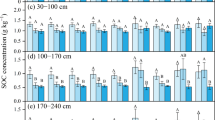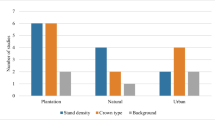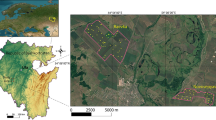Abstract
Estimation of yield or other fruit quality parameter is of great interest to farmers to decide on management actions just before harvesting and, in any case, to anticipate and plan harvesting operations. Making accurate and reliable estimates often requires systematic sampling that, when covering the whole plot, can result in the use of a large number of samples and a significant effort in time and cost for fruit growers. Faced with this whole area sampling strategy, simple random sampling (SRS) using reduced sample sizes is currently a widely used technique despite the less precise estimates that it provides. In this work, different stratified sampling schemes have been tested to estimate yield (kg/tree), fruit firmness (kg/cm2) and the refractometric index (ºBaumé) in a peach orchard located in Gimenells (Lleida, Catalonia, Spain). In contrast to SRS, the use of ancillary information (NDVI and apparent electrical conductivity, ECa) allowed sampling units or trees to be stratified according to two or three classes (strata) within the plot. The classes or homogeneous stratification zones were delimited by cluster analysis using, either separately or in combination, a multispectral airborne image (NDVI) and a ECa survey map acquired by means of a soil resistivity sensor (Veris 3100). Sampling schemes were then compared in terms of efficiency. In general, stratified sampling showed better results than SRS. Regarding yield estimates, stratified sampling according to two strata of NDVI allowed the sample size to be reduced by 17% compared to the SRS for the same precision. On the other hand, quality parameters may require different stratification strategies concerning the number of strata to be used. While ºBaumé was better-estimated using also stratified samples based on two strata of NDVI, fruit firmness showed better results when stratifying by three classes or strata of NDVI. In any case, neither the ECa nor the combined use of NDVI + ECa have improved sampling efficiency when used as ancillary maps for stratification.



Similar content being viewed by others
References
Anselin, L., Syabri, I., & Kho, Y. (2010). GeoDa: An introduction to spatial data analysis. In M. M. Fischer & A. Getis (Eds.), Handbook of applied spatial analysis (pp. 73–89). Berlin, Germany: Springer.
Brus, D. J. (1994). Improving design-based estimation of spatial means by soil map stratification. A case study of phosphate saturation. Geoderma, 62, 233–246.
Brus, D. J., & de Gruijter, J. J. (1997). Random sampling or geostatistical modelling? Choosing between design-based and model-based sampling strategies for soil (with Discussion). Geoderma, 80, 1–44.
Carrillo, E., Matese, A., Rousseau, J., & Tisseyre, B. (2016). Use of multi-spectral airborne imagery to improve yield sampling in viticulture. Precision Agriculture, 17, 74–92.
Cochran, W. G. (1977). Sampling techniques (p. 428). New York, NY, USA: Wiley.
Efron, B. (1982). The Jackknife, the Bootstrap and Other Resampling Plans. CBMS-NSF Regional Conference Series in Applied Mathematics, Philadelphia, PA, USA: Society for Industrial and Applied Mathematics. 85 p.
Fortes, R., Prieto, M. H., García-Martín, A., Córdoba, A., Martínez, L., & Campillo, C. (2015). Using NDVI and guided sampling to develop yield prediction maps of processing tomato crop. Spanish Journal of Agricultural Research, 13(1), e02–004.
Guastaferro, F., Castrignanò, A., De Benedetto, D., Sollitto, D., Troccoli, A., & Cafarelli, B. (2010). A comparison of different algorithms for the delineation of management zones. Precision Agriculture, 11, 600–620.
Jensen, J. R. (1996). Introductory digital image processing: A remote sensing perspective (p. 316). Englewood Cliffs, NJ, USA: Prentice Hall.
Kazmierski, M., Glemas, P., Rousseau, J., & Tisseyre, B. (2011). Temporal stability of within-field patterns of NDVI in non-irrigated Mediterranean vineyards. Journal International des Sciences de la Vigne et du Vin, 45(2), 61–73.
Lark, R. M., & Marchant, B. P. (2009). Using advanced methods to reduce the cost of soil sampling; ideas for the future. R&D Conference ‘Precision in arable farming: current practice and future potential’, Grantham, Lincolnshire, UK, 28th–29th October 2009. pp. 18–25 ref.6. https://www.cabdirect.org/cabdirect/FullTextPDF/2010/20103068758.pdf.
Martínez-Casasnovas, J. A., Agelet-Fernandez, J., Arnó, J., & Ramos, M. C. (2012). Analysis of vineyard differential management zones and relation to vine development, grape maturity and quality. Spanish Journal of Agricultural Research, 10(2), 326–337.
Meyers, J. M., Sacks, G. L., van Es, H. M., & Vanden Heuvel, J. E. (2011). Improving vineyard sampling efficiency via dynamic spatially explicit optimisation. Australian Journal of Grape and Wine Research, 17, 306–315.
Meyers, J. M., & Vanden Heuvel, J. E. (2014). Research note. Use of normalized difference vegetation index images to optimize vineyard sampling protocols. American Journal of Enology and Viticulture, 65(2), 250–253.
Miranda, C., & Royo, J. B. (2003). A statistical model to estimate potential yields in peach before bloom. Journal of the American Society for Horticultural Science, 128, 297–301.
Miranda, C., Santesteban, L. G., Urrestarazu, J., Loidi, M., & Royo, J. B. (2018). Sampling stratification using aerial imagery to estimate fruit load in peach tree orchards. Agriculture, 8(6), 78. https://doi.org/10.3390/agriculture8060078.
Miranda, C., Urretavizcaya, I., Santesteban, L. G., & Royo, J. B. (2015). Sampling stratification using aerial imagery to estimate fruit load and hail damage in nectarine trees. In J. V. Stafford (Ed.) Precision Agriculture’15, Proceedings of the 10th European Conference on Precision Agriculture, Wageningen, The Netherlands: Wageningen Academic Publishers, pp. 541–546.
Monestiez, P., Audergon, J. M., & Habib, R. (1990). Spatial dependences and sampling in a fruit tree: a geostatistical approach. Institut National de la Recherche Agronomique, Technical Report No. 163, 30 p.
Moral, F. J., Terrón, J. M., & Marques da Silva, J. R. (2010). Delineation of management zones using mobile measurements of soil apparent electrical conductivity and multivariate geostatistical techniques. Soil Tillage Research, 106, 335–343.
Ortega-Blu, R., & Molina-Roco, M. (2016). Evaluation of vegetation indices and apparent soil electrical conductivity for site-specific vineyard management in Chile. Precision Agriculture, 17, 434–450.
Peralta, N. R., & Costa, J. L. (2013). Delineation of management zones with soil apparent electrical conductivity to improve nutrient management. Computers and Electronics in Agriculture, 99, 218–226.
Soil Survey Staff. (2014). Keys to soil taxonomy (12th ed.). Washington, USA: USDA-Natural Resources Conservation Service.
Sudduth, K. A., Kitchen, N. R., Wiebold, W. J., Batchelor, W. D., Bollero, G. A., Bullock, D. G., et al. (2005). Relating apparent electrical conductivity to soil properties across the north-central USA. Computers and Electronics in Agriculture, 46, 263–283.
Taylor, J., Acevedo-Opazo, C., Ojeda, H., & Tisseyre, B. (2010). Identification and significance of sources of spatial variability in grapevine water status. Australian Journal of Grape and Wine Research, 16, 218–226.
Taylor, J., Tisseyre, B., Bramley, R., & Reid, A. (2005). A comparison of the spatial variability of vineyard yield in European and Australian production systems. In J. V. Stafford (Ed.) Precision Agriculture’05, Proceedings of the 5th European Conference on Precision Agriculture, Wageningen, The Netherlands: Wageningen Academic Publishers, pp. 907–914.
Uribeetxebarria, A., Arnó, J., Escolà, A., & Martínez-Casasnovas, J. A. (2018). Apparent electrical conductivity and multivariate analysis of soil properties to assess soil constraints in orchards affected by previous parcelling. Geoderma, 319, 185–193.
Vanden Heuvel, J. E., Leonardos, E. D., Proctor, J. T. A., Fisher, K. H., & Sullivan, J. A. (2002). Translocation and partitioning patterns of 14C photoassimilate from light- and shade- adapted shoots in greenhouse-grown ‘Chardonnay’ grapevines (Vitis vinifera L.). Journal of the American Society for Horticultural Science, 127, 912–918.
Webster, R., & Lark, R. M. (2013). Field sampling for environmental science and management (p. 192). London and New York: Routledge.
Wulfsohn, D., Aravena Zamora, F., Potin Téllez, C., Zamora Lagos, I., & García-Fiñana, M. (2012). Multilevel systematic sampling to estimate total fruit number for yield forecasts. Precision Agriculture, 13, 256–275.
Zude-Sasse, M., Fountas, S., Gemtos, T. A., & Abu-Khalaf, N. (2016). Applications of precision agriculture in horticultural crops. European Journal of Horticultural Science, 81(2), 78–90.
Acknowledgements
This work was funded by the Spanish Ministry of Economy and Competitiveness through the project AgVANCE (AGL2013-48297-C2-2-R). The authors also thank the IRTA Experimental Station in Gimenells (Lleida, Spain) for the possibility of carrying out this sampling study on a peach orchard.
Author information
Authors and Affiliations
Corresponding author
Rights and permissions
About this article
Cite this article
Uribeetxebarria, A., Martínez-Casasnovas, J.A., Escolà, A. et al. Stratified sampling in fruit orchards using cluster-based ancillary information maps: a comparative analysis to improve yield and quality estimates. Precision Agric 20, 179–192 (2019). https://doi.org/10.1007/s11119-018-9619-9
Published:
Issue Date:
DOI: https://doi.org/10.1007/s11119-018-9619-9




